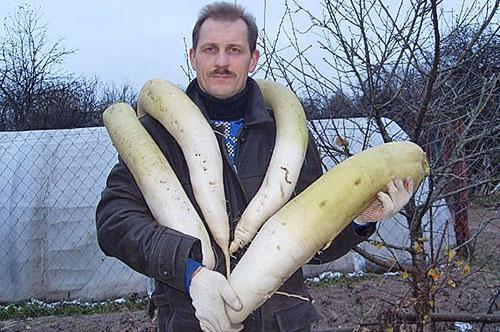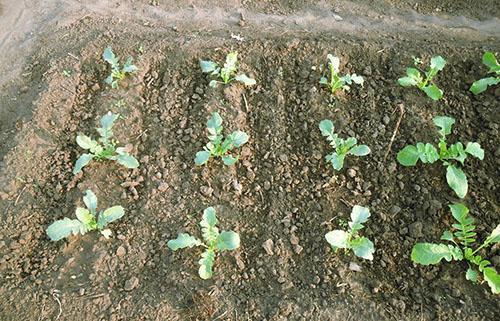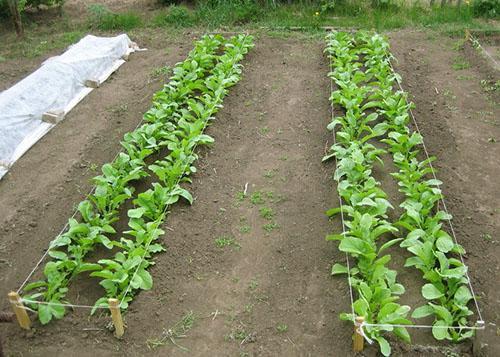Everything you need to know about Daikon radish
 The Japanese variety of radish is better known as daikon radish or sweet radish. For Japan, this culture is as important as potatoes for Russia. Daikon contains a lot of carbohydrates, but it is a dietary product. The vegetable is consumed in salted and fried form, used to prepare salads without cooking. There are many types of daikon. There are varieties of round and elongated root crops, with red, purple and snow-white pulp.
The Japanese variety of radish is better known as daikon radish or sweet radish. For Japan, this culture is as important as potatoes for Russia. Daikon contains a lot of carbohydrates, but it is a dietary product. The vegetable is consumed in salted and fried form, used to prepare salads without cooking. There are many types of daikon. There are varieties of round and elongated root crops, with red, purple and snow-white pulp.
When to plant Daikon radish

For vegetarians and those who watch their weight, daikon radish is a perfectly balanced product that contains 21 calories per 100 grams of pulp.
Sowing daikon is carried out in July in order to get full-fledged root crops by the autumn frosts. A daikon radish is planted when the bed is freed from the early ripening culture in early July. So that the radish does not go into color, they use varieties - Minovase, Summercross, Elephant's Fang, Dragon.
Soil requirements radish care
 The best predecessor for daikon is strawberry. Usually in the middle of summer, old bushes are destroyed, the garden is filled with fresh fertilizers. Digging the ridge is not necessary. You need to cut the greens from the bushes, and leave the roots to fertilize the soil.
The best predecessor for daikon is strawberry. Usually in the middle of summer, old bushes are destroyed, the garden is filled with fresh fertilizers. Digging the ridge is not necessary. You need to cut the greens from the bushes, and leave the roots to fertilize the soil.
With a garden drill, you need to make holes in the sowing points and fill them with fertile soil. The root crop can go deep into the ground up to 60 cm, and this depth should be provided with food. The distance between roots should be 40-50 cm.
Each root crop can reach a weight of 5 kg and a size of 60 cm. Therefore, rare planting of plants allows them not to shade each other.
 Several peas are sown in each nest, so that later on to leave the strongest plant. Thinning is carried out gradually, as the plants develop. Radish care includes:
Several peas are sown in each nest, so that later on to leave the strongest plant. Thinning is carried out gradually, as the plants develop. Radish care includes:
- weed removal;
- thinning of seedlings;
- regular watering;
- insect pest control.
To prevent crusting on the ground, the soil around the plants should be mulched. In this case, free space is left near the rosette of leaves. If the root crop rises above the surface of the ground during filling, it should be spud like a carrot. At the very beginning of August, for the rapid growth of the outlet, the plant needs to be fed with chicken infusion.
 When growing daikon radish, you need to know that it is attacked by the same pests as cabbage. Therefore, ash and repelling bedding and dusting will help to avoid pest infestation of the plantation.
When growing daikon radish, you need to know that it is attacked by the same pests as cabbage. Therefore, ash and repelling bedding and dusting will help to avoid pest infestation of the plantation.
Systematic treatment of the entire vegetable garden from pests using biological preparations will heal the land and raise the immunity of plants.
 At the same time, conditions should be created to protect the pouring root crop from damage by earth pests - wireworm, beetle larva or scoops. Any violation of the shell of the root vegetable makes it unfit for storage.
At the same time, conditions should be created to protect the pouring root crop from damage by earth pests - wireworm, beetle larva or scoops. Any violation of the shell of the root vegetable makes it unfit for storage.
How to protect a plant from flowering and storage of root crops
 Shooting daikon radish is the desire to give offspring. Nature has laid down the biological cycle of plant development, and with a long day, it must begin reproduction.Therefore, the artificial creation of a 12-hour day can save the plant from the release of the peduncle. But if at the same time there is a lack of moisture, thickening of the planting, arrows will appear for these reasons.
Shooting daikon radish is the desire to give offspring. Nature has laid down the biological cycle of plant development, and with a long day, it must begin reproduction.Therefore, the artificial creation of a 12-hour day can save the plant from the release of the peduncle. But if at the same time there is a lack of moisture, thickening of the planting, arrows will appear for these reasons.
The day before harvesting, the garden bed should be watered so that the next day it will be easier to remove the plant from the wet soil without damage. The daikon radish removed in dry weather should be dried, the soil removed from it and the petioles should be cut flush. Store root vegetables at a low temperature in the cellar. If the root is stored in the refrigerator, you will need to wrap it in plastic or plastic wrap.
Eating Daikon radish
 During storage, the activity of enzymes in the root crop increases. Therefore, by the spring it becomes a valuable vitamin supplement. The value of daikon is not only in beneficial nutrients, but also in its medicinal properties. During the growth process, this vegetable does not pick up harmful substances from the soil.
During storage, the activity of enzymes in the root crop increases. Therefore, by the spring it becomes a valuable vitamin supplement. The value of daikon is not only in beneficial nutrients, but also in its medicinal properties. During the growth process, this vegetable does not pick up harmful substances from the soil.
It does not have the harsh radish flavor and does not convey the radish aroma. Therefore, dishes made from it taste good without undue harshness. Young greens are also used in food as a vitamin supplement in salad. Daikon promotes the absorption of other foods and is recommended for diabetics.
No matter how useful the vegetable is, but for those who have already acquired diseases of internal organs, you should consult with your doctor before including the daikon in your menu. Excessive consumption of daikon, even by a healthy person, leads to large gas formation in the intestines.